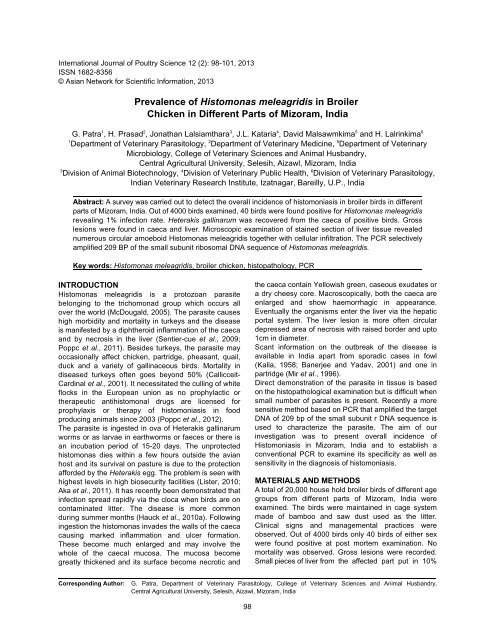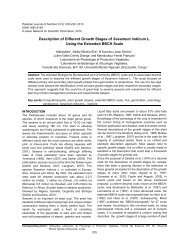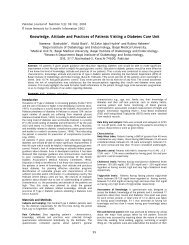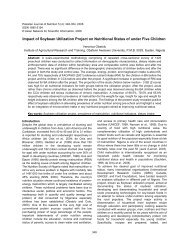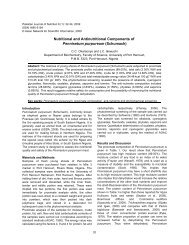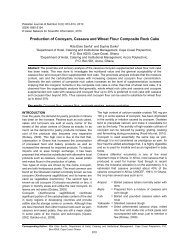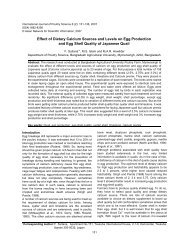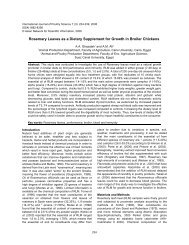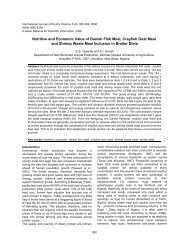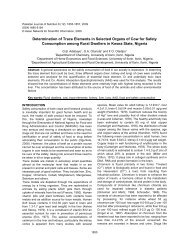Prevalence of Histomonas meleagridis in Broiler Chicken in ...
Prevalence of Histomonas meleagridis in Broiler Chicken in ...
Prevalence of Histomonas meleagridis in Broiler Chicken in ...
You also want an ePaper? Increase the reach of your titles
YUMPU automatically turns print PDFs into web optimized ePapers that Google loves.
International Journal <strong>of</strong> Poultry Science 12 (2): 98-101, 2013<br />
ISSN 1682-8356<br />
© Asian Network for Scientific Information, 2013<br />
<strong>Prevalence</strong> <strong>of</strong> <strong>Histomonas</strong> <strong>meleagridis</strong> <strong>in</strong> <strong>Broiler</strong><br />
<strong>Chicken</strong> <strong>in</strong> Different Parts <strong>of</strong> Mizoram, India<br />
1 2 3 4 5 6<br />
G. Patra , H. Prasad , Jonathan Lalsiamthara , J.L. Kataria , David Malsawmkima and H. Lalr<strong>in</strong>kima<br />
1 2 5<br />
Department <strong>of</strong> Veter<strong>in</strong>ary Parasitology, Department <strong>of</strong> Veter<strong>in</strong>ary Medic<strong>in</strong>e, Department <strong>of</strong> Veter<strong>in</strong>ary<br />
Microbiology, College <strong>of</strong> Veter<strong>in</strong>ary Sciences and Animal Husbandry,<br />
Central Agricultural University, Selesih, Aizawl, Mizoram, India<br />
Division <strong>of</strong> Animal Biotechnology, Division <strong>of</strong> Veter<strong>in</strong>ary Public Health, Division <strong>of</strong> Veter<strong>in</strong>ary Parasitology,<br />
Indian Veter<strong>in</strong>ary Research Institute, Izatnagar, Bareilly, U.P., India<br />
3 4 6<br />
Abstract: A survey was carried out to detect the overall <strong>in</strong>cidence <strong>of</strong> histomoniasis <strong>in</strong> broiler birds <strong>in</strong> different<br />
parts <strong>of</strong> Mizoram, India. Out <strong>of</strong> 4000 birds exam<strong>in</strong>ed, 40 birds were found positive for <strong>Histomonas</strong> <strong>meleagridis</strong><br />
reveal<strong>in</strong>g 1% <strong>in</strong>fection rate. Heterakis gall<strong>in</strong>arum was recovered from the caeca <strong>of</strong> positive birds. Gross<br />
lesions were found <strong>in</strong> caeca and liver. Microscopic exam<strong>in</strong>ation <strong>of</strong> sta<strong>in</strong>ed section <strong>of</strong> liver tissue revealed<br />
numerous circular amoeboid <strong>Histomonas</strong> <strong>meleagridis</strong> together with cellular <strong>in</strong>filtration. The PCR selectively<br />
amplified 209 BP <strong>of</strong> the small subunit ribosomal DNA sequence <strong>of</strong> <strong>Histomonas</strong> <strong>meleagridis</strong>.<br />
Key words: <strong>Histomonas</strong> <strong>meleagridis</strong>, broiler chicken, histopathology, PCR<br />
INTRODUCTION<br />
<strong>Histomonas</strong> <strong>meleagridis</strong> is a protozoan parasite<br />
belong<strong>in</strong>g to the trichomonad group which occurs all<br />
over the world (McDougald, 2005). The parasite causes<br />
high morbidity and mortality <strong>in</strong> turkeys and the disease<br />
is manifested by a diphtheroid <strong>in</strong>flammation <strong>of</strong> the caeca<br />
and by necrosis <strong>in</strong> the liver (Sentier-cue et al., 2009;<br />
Poppc et al., 2011). Besides turkeys, the parasite may<br />
occasionally affect chicken, partridge, pheasant, quail,<br />
duck and a variety <strong>of</strong> gall<strong>in</strong>aceous birds. Mortality <strong>in</strong><br />
diseased turkeys <strong>of</strong>ten goes beyond 50% (Callicceit-<br />
Card<strong>in</strong>al et al., 2001). It necessitated the cull<strong>in</strong>g <strong>of</strong> white<br />
flocks <strong>in</strong> the European union as no prophylactic or<br />
therapeutic antihistomonal drugs are licensed for<br />
prophylaxis or therapy <strong>of</strong> histomoniasis <strong>in</strong> food<br />
produc<strong>in</strong>g animals s<strong>in</strong>ce 2003 (Poppc et al., 2012).<br />
The parasite is <strong>in</strong>gested <strong>in</strong> ova <strong>of</strong> Heterakis gall<strong>in</strong>arum<br />
worms or as larvae <strong>in</strong> earthworms or faeces or there is<br />
an <strong>in</strong>cubation period <strong>of</strong> 15-20 days. The unprotected<br />
histomonas dies with<strong>in</strong> a few hours outside the avian<br />
host and its survival on pasture is due to the protection<br />
afforded by the Heterakis egg. The problem is seen with<br />
highest levels <strong>in</strong> high biosecurity facilities (Lister, 2010;<br />
Aka et al., 2011). It has recently been demonstrated that<br />
<strong>in</strong>fection spread rapidly via the cloca when birds are on<br />
contam<strong>in</strong>ated litter. The disease is more common<br />
dur<strong>in</strong>g summer months (Hauck et al., 2010a). Follow<strong>in</strong>g<br />
<strong>in</strong>gestion the histomonas <strong>in</strong>vades the walls <strong>of</strong> the caeca<br />
caus<strong>in</strong>g marked <strong>in</strong>flammation and ulcer formation.<br />
These become much enlarged and may <strong>in</strong>volve the<br />
whole <strong>of</strong> the caecal mucosa. The mucosa become<br />
greatly thickened and its surface become necrotic and<br />
the caeca conta<strong>in</strong> Yellowish green, caseous exudates or<br />
a dry cheesy core. Macroscopically, both the caeca are<br />
enlarged and show haemorrhagic <strong>in</strong> appearance.<br />
Eventually the organisms enter the liver via the hepatic<br />
portal system. The liver lesion is more <strong>of</strong>ten circular<br />
depressed area <strong>of</strong> necrosis with raised border and upto<br />
1cm <strong>in</strong> diameter.<br />
Scant <strong>in</strong>formation on the outbreak <strong>of</strong> the disease is<br />
available <strong>in</strong> India apart from sporadic cases <strong>in</strong> fowl<br />
(Kalia, 1958; Banerjee and Yadav, 2001) and one <strong>in</strong><br />
partridge (Mir et al., 1996).<br />
Direct demonstration <strong>of</strong> the parasite <strong>in</strong> tissue is based<br />
on the histopathological exam<strong>in</strong>ation but is difficult when<br />
small number <strong>of</strong> parasites is present. Recently a more<br />
sensitive method based on PCR that amplified the target<br />
DNA <strong>of</strong> 209 bp <strong>of</strong> the small subunit r DNA sequence is<br />
used to characterize the parasite. The aim <strong>of</strong> our<br />
<strong>in</strong>vestigation was to present overall <strong>in</strong>cidence <strong>of</strong><br />
Histomoniasis <strong>in</strong> Mizoram, India and to establish a<br />
conventional PCR to exam<strong>in</strong>e its specificity as well as<br />
sensitivity <strong>in</strong> the diagnosis <strong>of</strong> histomoniasis.<br />
MATERIALS AND METHODS<br />
A total <strong>of</strong> 20,000 house hold broiler birds <strong>of</strong> different age<br />
groups from different parts <strong>of</strong> Mizoram, India were<br />
exam<strong>in</strong>ed. The birds were ma<strong>in</strong>ta<strong>in</strong>ed <strong>in</strong> cage system<br />
made <strong>of</strong> bamboo and saw dust used as the litter.<br />
Cl<strong>in</strong>ical signs and managemental practices were<br />
observed. Out <strong>of</strong> 4000 birds only 40 birds <strong>of</strong> either sex<br />
were found positive at post mortem exam<strong>in</strong>ation. No<br />
mortality was observed. Gross lesions were recorded.<br />
Small pieces <strong>of</strong> liver from the affected part put <strong>in</strong> 10%<br />
Correspond<strong>in</strong>g Author: G. Patra, Department <strong>of</strong> Veter<strong>in</strong>ary Parasitology, College <strong>of</strong> Veter<strong>in</strong>ary Sciences and Animal Husbandry,<br />
Central Agricultural University, Selesih, Aizawl, Mizoram, India<br />
98
formal<strong>in</strong> sal<strong>in</strong>e and subsequently processed for<br />
histopathological studies. Haematoxyl<strong>in</strong> and Eos<strong>in</strong> was<br />
used for sta<strong>in</strong><strong>in</strong>g tissue as per standard sta<strong>in</strong><strong>in</strong>g<br />
technique. The sta<strong>in</strong>ed slides were exam<strong>in</strong>ed under<br />
light microscope.<br />
The PCR was done as per Huber et al. (2005). The PCR<br />
DNA was extracted from approximately 250 mg <strong>of</strong> liver<br />
tissue with Hipura Tm mammalian genomic DNA<br />
m<strong>in</strong>iprep purification sp<strong>in</strong> kit (HIMEDIA). The tissue were<br />
thawed and 250 mg pieces removed mashed up us<strong>in</strong>g<br />
scissor, vortexed and then <strong>in</strong>cubated overnight <strong>in</strong> an<br />
water bath with protease k. The tissues were further<br />
processed accord<strong>in</strong>g to the manufacturer’s protocol and<br />
from the sample 10 µl <strong>of</strong> eluted DNA were used for PCR<br />
amplification.<br />
Int. J. Poult. Sci., 12 (2): 98-101, 2013<br />
DNA amplification: Reaction mixture (50µl) for each<br />
sample conta<strong>in</strong>ed 10 mM Tris-HCl (pH 8.3), 50 mM KCl,<br />
2mM MgCl 2, 200µm <strong>of</strong> each deoxyribonucleotide, 100p<br />
mol <strong>of</strong> each oligonucleotide primer and target DNA. The<br />
forward primer for histomonas <strong>meleagridis</strong> was<br />
designated as HIS 5FC(5’-CCTTTAGATGCTCTGG<br />
GCTG-3’) and the reverse primer was HIS 5R (5’-<br />
CAGGGACGTATTCAACGTG-3’) as per Huber et al.<br />
(2005). The PCR was done <strong>in</strong> Master cycler Gradient<br />
Mach<strong>in</strong>e (Eppendr<strong>of</strong>, Germany).<br />
RESULTS<br />
The affected birds showed <strong>in</strong>appetence, ruffled feathers,<br />
and slight yellowish appearance <strong>of</strong> combs and wattles.<br />
The dropp<strong>in</strong>gs <strong>of</strong> positive cases were watery and<br />
yellowish <strong>in</strong> colour with streaks <strong>of</strong> white mucus. Gross<br />
liver lesions <strong>in</strong>cluded yellowish circumscribed<br />
depressed necrotic areas with raised border with a<br />
diameter <strong>of</strong> 2 mm to 1 cm (Fig. 1). Caecal walls were<br />
severely thickened, the lumens were distended with<br />
caseous cores and the mucosa were ulcerated.<br />
Heterakis gall<strong>in</strong>arum was found <strong>in</strong> caeca <strong>of</strong> positive<br />
birds (Fig. 2).<br />
Microscopically vary<strong>in</strong>g amounts <strong>of</strong> histomonas<br />
trophozoites were detected <strong>in</strong> liver (Fig. 3). Mononuclear<br />
cellular <strong>in</strong>filtration <strong>of</strong>ten conta<strong>in</strong><strong>in</strong>g giant cells, necrosis<br />
<strong>of</strong> hepatocytes and <strong>in</strong>filtration <strong>of</strong> macrophages were the<br />
predom<strong>in</strong>ant microscopic lesions <strong>in</strong> the liver. There<br />
were multifocal necrosis and granulomatous<br />
<strong>in</strong>flammation <strong>in</strong> the caeca. The PCR selectively<br />
amplified 209 bp <strong>of</strong> the small subunit ribosomal DNA<br />
sequence <strong>of</strong> <strong>Histomonas</strong> <strong>meleagridis</strong> (Fig. 4).<br />
The percent prevalence <strong>of</strong> histomoniasis <strong>in</strong> different<br />
parts <strong>of</strong> Mizoram, India is presented <strong>in</strong> Table 1.<br />
DISCUSSION<br />
No birds were found dead due to histomoniasis dur<strong>in</strong>g<br />
<strong>in</strong>vestigation but caecal and hepatic lesions were<br />
observed. Histomoniasis is essentially a disease <strong>of</strong><br />
turkeys but chicken are also occasionally found to be<br />
Fig. 1: Gross lesions <strong>in</strong> the liver show<strong>in</strong>g characteristic<br />
circular depressed necrotic lesions due to<br />
<strong>Histomonas</strong> <strong>meleagridis</strong><br />
Fig. 2: Histopathological sta<strong>in</strong>ed (H and E) section <strong>of</strong><br />
liver show<strong>in</strong>g numerous amoeboid <strong>Histomonas</strong><br />
<strong>meleagridis</strong>(10X)<br />
<strong>in</strong>fected (Kaufmann, 1996). Histomoniasis is detected<br />
and described <strong>in</strong> naturally affected 400 broiler birds<br />
(Table 1). The highest <strong>in</strong>cidence <strong>of</strong> <strong>in</strong>fection is recorded<br />
from Aizawl District <strong>of</strong> Mizoram (3%). Heterakis<br />
gall<strong>in</strong>arum was recovered at post mortem exam<strong>in</strong>ation<br />
from all the <strong>in</strong>fected birds from this area suggest<strong>in</strong>g<br />
vector potentiality <strong>of</strong> the ceacal worm for this protozoan.<br />
This is the first report <strong>of</strong> naturally occurr<strong>in</strong>g systemic<br />
histomoniasis <strong>in</strong> broiler birds from Mizoram, India. The<br />
presence <strong>of</strong> histomoniasis was l<strong>in</strong>ked to cleanl<strong>in</strong>ess <strong>of</strong><br />
the build<strong>in</strong>g, wet litter and diarrhoea. In the present study<br />
Heterakis gall<strong>in</strong>arum was recovered from the caeca <strong>of</strong><br />
the affected birds dur<strong>in</strong>g post mortem exam<strong>in</strong>ation.<br />
Heterakis gall<strong>in</strong>arum is a common nematode parasite<br />
<strong>of</strong> the domestic chicken and turkey. The ma<strong>in</strong> route <strong>of</strong><br />
histomonas <strong>in</strong>fection is by <strong>in</strong>gestion <strong>of</strong> the embryonated<br />
eggs <strong>of</strong> the caecal worm Heterakis gall<strong>in</strong>arum.<br />
99
Fig. 3: Adult Heterakis gall<strong>in</strong>arum worm<br />
M L1 L2 L3<br />
Fig. 4: PCR amplification <strong>of</strong> <strong>Histomonas</strong> <strong>meleagridis</strong><br />
Agarose gel electrophoresis <strong>of</strong> the PCR products.<br />
Lane 1 Lane 2 and Lane 3: Amplified PCR<br />
products obta<strong>in</strong>ed from tests <strong>of</strong> DNA extracted<br />
from liver tissue samples. Lane M: 100 bp marker<br />
Table 1: <strong>Prevalence</strong> <strong>of</strong> <strong>Histomonas</strong> <strong>meleagridis</strong> broiler chicken <strong>in</strong><br />
different parts <strong>of</strong> Mizoram, India<br />
No. <strong>of</strong><br />
Positive<br />
Place birds exam<strong>in</strong>ed No. (%)<br />
Durtlang 525 5 0.8<br />
Aizawl 400 12 3*<br />
Saiha 175 1 0.57<br />
Kolasib 700 6 0.87<br />
Champhai 625 4 0.64<br />
Langtlai 565 3 0.53<br />
Serchip 330 3 0.99<br />
Int. J. Poult. Sci., 12 (2): 98-101, 2013<br />
01<br />
209 bp<br />
<strong>in</strong>digenous fowls. Indian Vet. J., 35: 105-107.<br />
Lunglei 355 3 0.84 Kaufmann, J., 1996. Parasitic <strong>in</strong>fections <strong>of</strong> domestic<br />
Mammit 325 3 0.92<br />
*Significant level (p
Int. J. Poult. Sci., 12 (2): 98-101, 2013<br />
McDougald, L.R., 1997. Other protozoan diseases <strong>of</strong> the Poppc, R. Hauck, B. Blazer, A. Kanel and H.M. Hafez,<br />
<strong>in</strong>test<strong>in</strong>al tract. Pages 890-899 <strong>in</strong> Diseases <strong>of</strong> 2012. Recurr<strong>in</strong>g histomoniasis <strong>in</strong> an organic farm.<br />
Poultry. 10th ed. B.W. Calnek, Iowa State Univ. Avian Dis., 55: 328-330.<br />
Press, Ames, IA. Sentier-Cue, G., R.P. Ch<strong>in</strong> and H.L. Shivaprasada, 2009.<br />
McDougald, L.R., 2005. Blackhead disease Systemic histomoniasis associated with high<br />
(Histomoniasis) <strong>in</strong> poultry, a critical review. Avian mortality and unusual lesions <strong>in</strong> the bursa <strong>of</strong><br />
Dis., 49: 462-76.<br />
Fabricius and lungs <strong>in</strong> commercial turkeys. Avian<br />
Mir, A.S., R.A. Sahardar, B.A. Pandit and M.A. Ahmed, Dis., 53: 231-238.<br />
1996. Occurrence <strong>of</strong> histomoniasis (enterohepatitis) Zaragatzki, E., M. Hess, E. Grabenste<strong>in</strong>er, F. Abde, Kar,<br />
<strong>in</strong> hen reared partridge (Gracia electoris) <strong>in</strong> Atrasheid and H. Mehlhorn, 2010. Light and<br />
Kashmir. Indian Vet. J., 13: 98-99.<br />
transmission electron microscopic studies on the<br />
Popp, C., R. Hauck, B. Blazey, A. Hanel and H.M. Hafez, encystations <strong>of</strong> <strong>Histomonas</strong> <strong>meleagridis</strong>. Parasitol<br />
2011. An unusual outbreak <strong>of</strong> histomoniasis <strong>in</strong> a Res., 106: 977-983.<br />
commercial turkey flock. Berl Munich Tierraztl Wschr,<br />
125: 153-158.<br />
101


